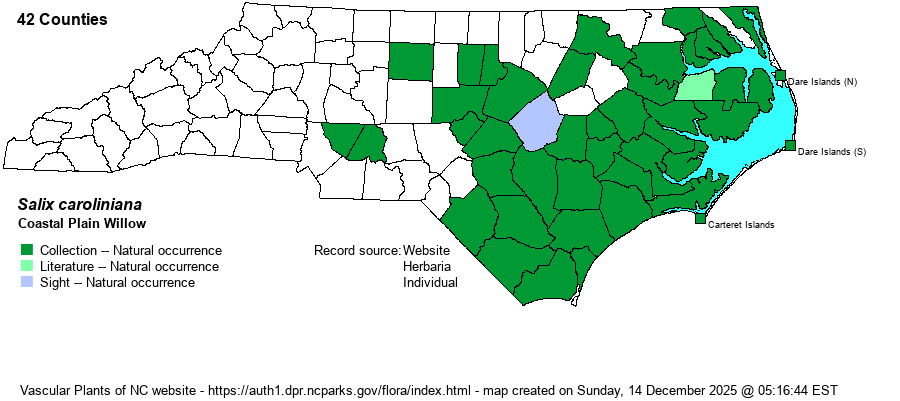| Author | Michaux | |
| Distribution | Throughout the Coastal Plain; sparingly in the Piedmont, mainly in the eastern and southern portions. Records for the southern Mountains probably are not natural occurrences.
This is a mostly Southern species with odd centers of abundance. It ranges north to MD south through FL, then west to eastern KS and central TX. However, it is very scarce in the southern Appalachians, and oddly scarce in the lower Mississippi River basin of MS and LA.
| |
| Abundance | Reasonably common in the Coastal Plain, especially so in the southern and central counties, where present in all counties there (except absent in the Sandhills). Rare to uncommon and local in the eastern and southern Piedmont, and very rare farther west. As this species can be confused with other willow species, the range west of the Coastal Plain needs better elucidation. | |
| Habitat | This species, as do most willows, favors full sun and moisture; thus, it is found in wet thickets, along creeks and ditches, on sandbars, around pools and pond margins, and opening or margins of bottomlands and swamps and in interdune marshes. |
| Phenology | Flowers and fruits in March and April. The fluffy seeds/fruit can often be seen drifting through wetlands in mid-spring. | |
| Identification | This is a small deciduous tree that grows to about 20-30 feet tall, generally shorter than the very similar Black Willow (Salix nigra). The leaves are very narrowly lanceolate, typically about 3 inches long, and occasionally up to 1-inch wide (though usually narrower). The main identification feature from Black Willow is the whitish/glaucous underside of the leaves, often easily visible at a distance or seen while driving along a nearby road. There are a few other subtle characters, but the leaf underside is the best mark. Note that Black Willow may often grow with Coastal Plain Willow; it is certainly not just a Piedmont or mountain species. | |
| Taxonomic Comments | None
The genus Salix is a very large and complex group of plants that vary from ground-hugging Arctic belly plants to huge trees. There are 113 species in North America alone, including introduced species. They are extremely important to browsing mammals -- rabbits, deer, elk, muskox, moose, many rodents -- and browsing birds like ptarmigan. Many birds use them to nest in. Here in NC we only have a small number of native species (5) and so do not appreciate the ecological importance of willows. We highly recommend reading the introductory pages of George Argus's FNA treatment (2010) and his excellent monograph on the willows of the southeastern U.S. (1986). The latter has drawings and descriptions of all southeastern U.S. taxa. Due to natural and horticultural hybridization, some plants will not key cleanly and you may have to compare your specimen with others verified by Argus. | |
| Other Common Name(s) | Carolina Willow, Ward Willow | |
| State Rank | S4? [S4S5] | |
| Global Rank | G5 | |
| State Status | | |
| US Status | | |
| USACE-agcp | OBL link |
| USACE-emp | OBL link |

